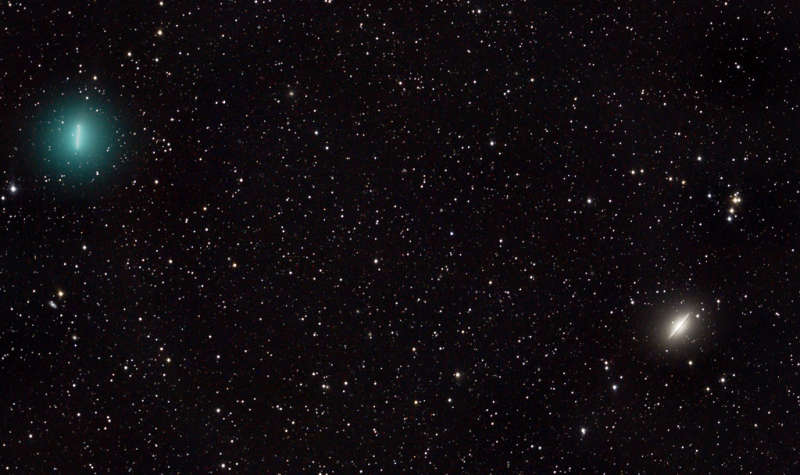
|
Credit & Copyright: Ian Griffin (Otago Museum)
Explanation:
Comet Iwamoto (C/2018 Y1), shows off
a pretty, greenish coma at the upper left in this telescopic
field of view.
Taken on February 4 from the
Mount
John Observatory, University of Canterbury,
the 30 minute long total exposure time shows
the comet sweeping quickly across a background of stars and
distant galaxies in the constellation Virgo.
The long exposure and Iwamoto's
rapid
motion relative to the stars and galaxies results
in the noticeable blurred streak tracing the the comet's bright inner coma.
In fact, the streaked coma gives the comet
a remarkably similar appearance to Messier 104 at lower right,
popularly known as the Sombrero Galaxy.
The comet, a visitor to the inner Solar System, is a mere 4
light-minutes away though, while
majestic
Messier 104, a spiral galaxy posing edge-on,
is 30 million light-years distant.
The first
binocular comet of 2019,
Iwamoto will pass closest to Earth on February 12.
This comet's highly elliptical orbit around the Sun stretches beyond the
Kuiper belt
with an estimated 1,371 year orbital period.
That should bring it back to the inner Solar System in 3390 AD.
|
January February March April May June July August September October November December |
| ||||||||||||||||||||||||||||||||||||||||||||||||
NASA Web Site Statements, Warnings, and Disclaimers
NASA Official: Jay Norris. Specific rights apply.
A service of: LHEA at NASA / GSFC
& Michigan Tech. U.
Based on Astronomy Picture
Of the Day
Publications with keywords: comet - M 104
Publications with words: comet - M 104
See also:
- APOD: 2025 December 1 Á 3I ATLAS: Tails of an Interstellar Comet
- APOD: 2025 November 25 Á Comet Lemmon and the Milky Way
- 3I/ATLAS: A View from Planet Earth
- APOD: 2025 November 17 Á Comet Lemmons Wandering Tail
- APOD: 2025 September 30 Á Comet Lemmon Brightens
- APOD: 2025 September 29 Á Two Camera Comets in One Sky
- APOD: 2025 September 26 Á A SWAN an ATLAS and Mars
